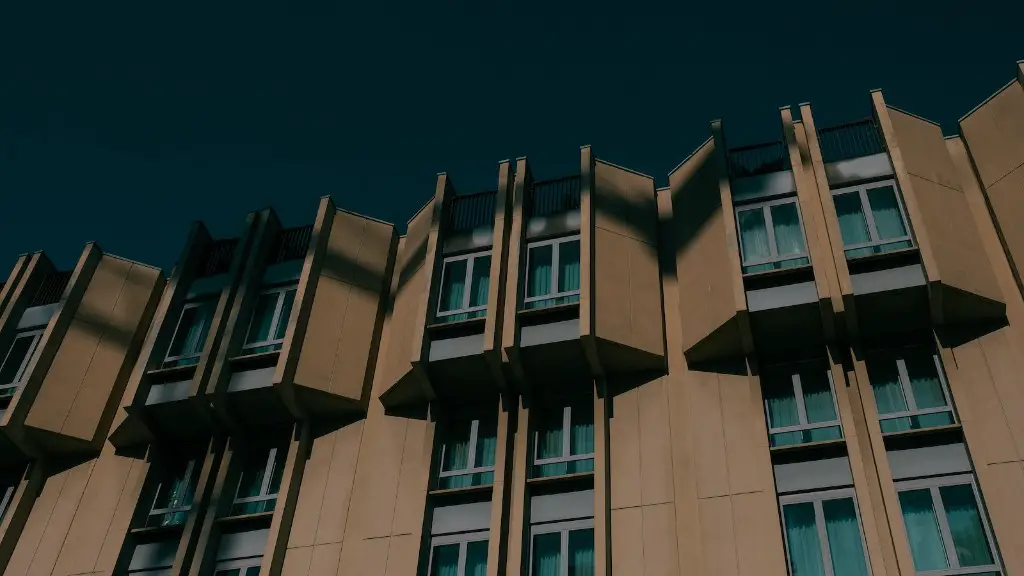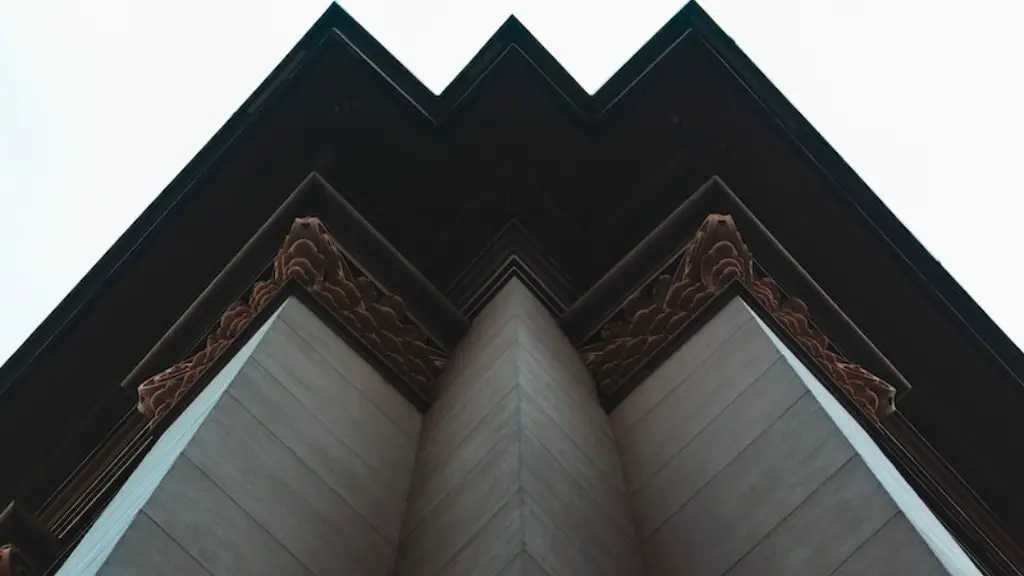What is Modernist Architecture? Modernist architecture is a style of architecture that emerged in the early 20th century. It generally involves flat planes, rectangular forms, and open plans that reject the traditional, more ornamental architectural styles of the past.
Modernist architecture was born out of a desire to make a more rationalized and simplified form of building, and to create more efficient spaces in which people could live, work, and move through. Its proponents argued that modern purpose-built buildings should reflect the ideas of progress and social progress.
Many of the leading modernist architects, such as Le Corbusier, Mies van der Rohe, and Walter Gropius, were pioneers of the Modern Movement, an international movement in the visual arts and architecture that emerged in the late 19th century. The movement rejected traditional, more decorative styles and sought to create an aesthetic and a functional design based on modern scientific and industrial principles.
One of the key characteristics of modernist architecture is its rejection of ornamentation, which the modernists saw as a distraction from the functional and utilitarian aspects of a building. Instead, they sought to simplify and reduce the forms of buildings to their essential elements. This included the use of simplified geometric shapes, such as rectangles, circles, and triangles, as well as the use of monochromatic color palettes. Another defining feature of modernist architecture was its minimalism: buildings were often reduced to simple blocks, with an emphasis on function rather than decoration.
Modernist architecture also sought to provide a new relationship between the building and its natural environment. Many modernists believed in designing structures that would blend into their surroundings, and that the use of organic forms and materials would be more visually appealing than traditional, rigid angular forms. This was particularly evident in the work of Frank Lloyd Wright, who was a pioneer of organic architecture.
The rejection of ornamentation, minimalism, and the use of organic forms, as well as the emphasis on function and a closer relationship to the natural environment, are all key characteristics of modernist architecture. The movement has had a significant impact on the way cities and buildings look today and continues to be a major influence in contemporary architecture.
Advantages of Modernist Architecture
Modernist architecture has a number of advantages. For one, its minimalism and simplicity are very efficient in terms of saving space and creating more efficient building designs. This efficiency can also translate into cost savings for developers, as modernist designs often use fewer materials and require less construction labor. Additionally, modernist buildings are often easier to maintain and repair, as their designs are typically less complex than traditional structures.
Modernist architecture also creates a sense of openness and light in the built environment. Many modernist buildings use large open plans, which allows for more natural light and creates a greater sense of space. This can result in a much more pleasant and calming experience for occupants, as opposed to traditional designs which often enclose and separate rooms.
In addition to these advantages, modernist architecture has become increasingly popular in recent years due to its aesthetic qualities. Its minimalist approach to form often results in a soothing and elegant appearance, in contrast to more ornamental designs. This is often seen in modern skyscrapers, which combine sleek lines and geometric shapes to create stunning visual statements.
Finally, modernist architecture often lasts much longer than traditional styles, as its designs are typically much easier to maintain and update as technology and society evolves. This longevity makes modernist structures an attractive choice for developers who want to create lasting achievements in the built environment.
Disadvantages of Modernist Architecture
Despite the advantages of modernist architecture, there are also some disadvantages. One of the most frequently noted is the lack of character and humanity. Modernist structures often lack the intricate details and personality that are found in older buildings. They can appear to be cold and unfeeling, which can make them less desirable places to live or work.
In addition, modernist designs can often be too simplistic and lack interest or dynamism. This can lead to a sense of monotony in the built environment, and it can be difficult to create a sense of community in areas where all of the buildings have the same appearance. Furthermore, the lack of decoration and ornamentation can make modernist buildings seem sterile and impersonal.
Modernist architecture can also be more expensive to construct than traditional designs, as the materials and labor required are often more expensive. Additionally, the lack of detail and complexity can make modernist designs more difficult and time-consuming to construct than traditional structures. This can ultimately lead to higher costs for developers.
Finally, many modernist designs are not particularly well-suited for certain climates or locations. The resulting structures can often be uncomfortable, especially in areas where the temperature fluctuates drastically. This can lead to issues with the building’s energy efficiency and make it more expensive to maintain in the long run.
Conclusion
Modernist architecture has a number of advantages and disadvantages, but it has become increasingly popular in the past few decades due to its efficiency, simplicity, and elegance. Its minimalist forms, open plans, and emphasis on natural light create an attractive aesthetic that has become a hallmark of contemporary architecture. While modernist designs can be expensive to construct, they often have a longer lifespan and are easier to maintain, making them a popular choice for developers.
Influential Architects
Modernist architecture has been influenced by a number of influential architects. Le Corbusier and Mies van der Rohe were some of the earliest and most prominent figures of the Modernist movement, and their work has had a massive impact on the way contemporary buildings are designed and constructed.
Frank Lloyd Wright was another major figure in the development of modernist architecture. His organic forms and focus on integrating buildings into their natural environment have been hugely influential in contemporary architecture.
Other influential figures in the modernist movement include Marcel Breuer, Louis Sullivan, Lúcio Costa, Ludwig Mies van der Rohe, and Alvar Aalto. Together, these architects have had a significant impact on the development of modernist architecture and its impact on the built environment.
Impact of Technology
Technology has had a major impact on the development of modernist architecture, particularly in terms of design and construction. Many modernist buildings, such as towers and skyscrapers, could not have been created without the advancements in technology that have occurred in recent decades.
Computer-aided design (CAD) software has enabled architects to create more detailed and accurate designs, which has allowed them to construct stronger and more efficient structures. In addition, advances in machine-based manufacturing have enabled builders to construct more complex designs quickly and efficiently.
Finally, the development of digital fabrication technology has made it possible to create intricate details in modernist structures, such as the use of metal cladding, intricate glass designs, and curved walls. This technology has enabled architects to create more intricate and visually appealing designs, without sacrificing the minimalism and efficiency of modernist architecture.
Environmental Impact
Modernist architecture has had a significant impact on the environment. Its efficient designs can lead to cost savings on construction and energy costs, as they are typically more energy-efficient than traditional designs. Additionally, modernist buildings often use natural light, which can help to reduce energy consumption.
The use of organic forms and materials can also help to create a more natural and aesthetically pleasing environment. The integration of greenery and natural elements into modernist structures can also benefit the local environment, as it can help to reduce pollution and improve air quality.
Finally, the use of technology to construct modernist structures can also help to reduce the environmental impact. Efficiency improvements in the construction process can reduce waste and minimize pollution levels, which can be beneficial to the local environment.





